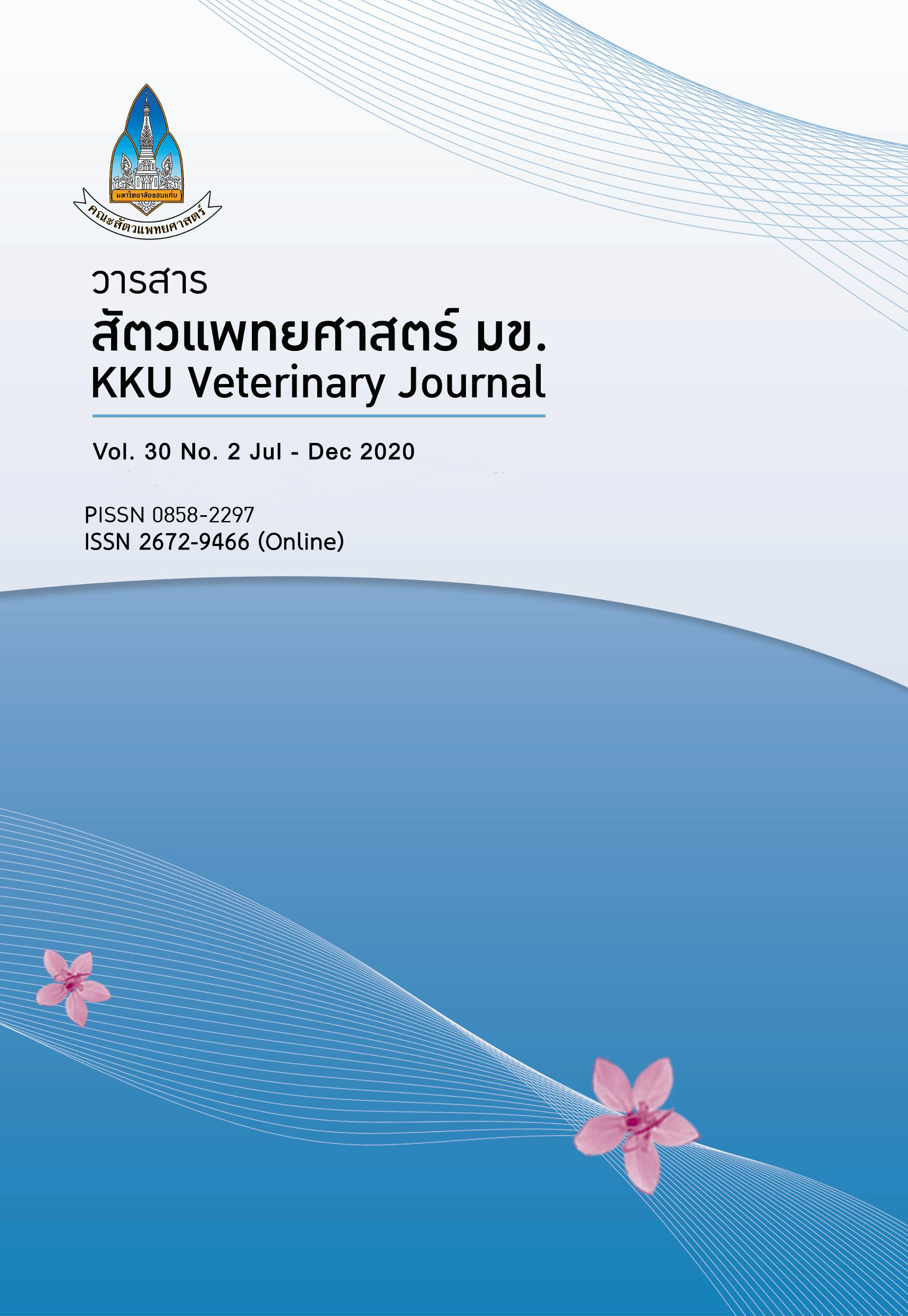การประเมินคะแนนแอพการ์ในลูกสุนัขจากการผ่าคลอดฉุกเฉินและไม่ฉุกเฉิน
Main Article Content
บทคัดย่อ
บทนำ การประเมินคะแนนแอพการ์เป็นวิธีประเมินลูกสุนัขแรกเกิดที่ทำได้ง่ายและเชื่อถือได้ เพื่อประเมินอัตราการมีชีวิตรอดในลูกสุนัขแรกเกิดเนื่องจากลูกสุนัขที่เกิดจากการผ่าคลอดจะมีโอกาสเสี่ยงสูงต่ออัตราการเสียชีวิต เนื่องจากยาสลบส่วนใหญ่สามารถแพร่ผ่านรกเข้าสู่ตัวลูกได้ นอกจากนี้พบว่าอัตราการตายของลูกสุนัขที่เกิดจากการผ่าคลอดฉุกเฉินมากกว่าการผ่าคลอดไม่ฉุกเฉิน ปัจจุบันโปรโพฟอลเป็นยาเหนี่ยวนำการสลบที่มีการใช้แพร่หลายในการผ่าคลอด อย่างไรก็ตามยังไม่มีการเปรียบเทียบคะแนนแอพการ์ระหว่างการผ่าคลอดฉุกเฉินและไม่ฉุกเฉินในลูกสุนัขแรกเกิด
วัตถุประสงค์ เพื่อประเมินคะแนนแอพการ์ของลูกสุนัขที่เกิดจากการผ่าคลอด โดยใช้โปรโพฟอลเป็นยาเหนี่ยวนำการสลบ และเปรียบเทียบคะแนนแอพการ์ระหว่างลูกสุนัขที่เกิดจากการผ่าคลอดฉุกเฉินและไม่ฉุกเฉิน
วัสดุ อุปกรณ์ และวิธีการ แม่สุนัขที่เข้ารับการผ่าคลอดได้รับการเหนี่ยวนำการสลบด้วยยาโปรโพฟอลและรักษาระดับการสลบด้วยยาดมสลบไอโซฟลูเรนร่วมกับออกซิเจน หลังจากนั้นทำการประเมินคะแนนแอพการ์ในลูกสุนัขแรกเกิดที่เวลา 5, 15 และ 60 นาทีหลังคลอด
ผลการศึกษา การศึกษานี้มีแม่สุนัขทั้งหมด 9 ตัว และลูกสุนัข 36 ตัว คะแนนแอพการ์ที่เวลา 5 นาทีหลังคลอดของลูกสุนัขที่เกิดจากการผ่าคลอดฉุกเฉินต่างจากลูกสุนัขที่เกิดจากการผ่าคลอดไม่ฉุกเฉินอย่างมีนัยสำคัญ นอกจากนี้ยังพบว่า 17.6% ของลูกสุนัขที่เกิดจากการผ่าคลอดฉุกเฉินถูกจัดอยู่ในกลุ่มที่มีภาวะเครียดรุนแรง อย่างไรก็ตามที่เวลา 60 นาทีหลังคลอด ลูกสุนัขทุกตัวจากทั้งสองกลุ่มจัดอยู่ในกลุ่มที่ไม่มีภาวะเครียดหลังคลอดและพบอัตราการรอดชีวิตของลูกสุนัข 91.1%
สรุป คะแนนแอพการ์ของลูกสุนัขที่เกิดจากการผ่าคลอดฉุกเฉินมีค่าน้อยกว่าลูกสุนัขที่เกิดจากการผ่าคลอดไม่ฉุกเฉิน โดยหลังจากช่วยชีวิตลูกสุนัขทุกตัวที่จัดอยู่ในกลุ่มที่มีภาวะเครียดรุนแรง พบว่าลูกสุนัขทุกตัวจัดอยู่ในกลุ่มที่ไม่มีภาวะเครียด ดังนั้นการประเมินลูกสุนัขแรกเกิดจึงมีความสำคัญอย่างยิ่งในการพยากรณ์การมีชีวิตรอดและเพื่อพิจารณาในการเริ่มช่วยชีวิตลูกสุนัขแรกเกิด เพื่อเพิ่มอัตราการมีชีวิตรอดในลูกสุนัขแรกเกิด
Article Details
เอกสารอ้างอิง
Apgar V, 1953. A proposal for a new method of evaluation of the newborn infant. Curr Res Anesth Analg 32(4), 260-267.
Batista M, Moreno C, Vilar J, Golding M, Brito C, Santana M and Alamo D, 2014. Neonatal viability evaluation by Apgar score in puppies delivered by cesarean section in two brachycephalic breeds (English and French bulldog). Anim Reprod Sci 146(3-4), 218-226.
Bergstrom A, Nodtvedt A, Lagerstedt AS and Egenvall A, 2006. Incidence and breed predilection for dystocia and risk factors for cesarean section in a Swedish population of insured dogs. Vet Surg 35(8), 786-791.
Conde Ruiz C. Rosset E and Portier K, 2017. Poor Apgar score and high mortality in puppies born by caesarean section from bitches anaesthetized with a propofol constant rate infusion. Vet Anaesth Analg 44(3), 692-693.
Doebeli A, Michel E, Bettschart R, Hartnack S and Reichler IM, 2013. Apgar score after induction of anesthesia for canine cesarean section with alfaxalone versus propofol. Theriogenology 80(8), 850-854.
Funkquist PM, Nyman GC, Lofgren AJ and Fahlbrink EM, 1997. Use of propofol-isoflurane as an anesthetic regimen for cesarean section in dogs. J Am Vet Med Assoc 211(3), 313-317.
Groppetti D, Di Cesare F, Pecile A, Cagnardi P, Merlanti R, D'Urso ES, Gioeni D, Boracchi P and Ravasio G, 2019. Maternal and neonatal wellbeing during elective C-section induced with a combination of propofol and dexmedetomidine: How effective is the placental barrier in dogs? Theriogenology 129, 90-98.
Littell RC, 2006. SAS for mixed models. Cary, NC, SAS Institute Inc.
Luna SP, Cassu RN, Castro GB, Teixeira Neto FJ, Silva Junior JR and Lopes MD, 2004. Effects of four anaesthetic protocols on the neurological and cardiorespiratory variables of puppies born by caesarean section. Vet Rec 154(13), 387-389.
Mila H, Grellet A, Delebarre M, Mariani C, Feugier A and Chastant-Maillard S, 2017. Monitoring of the newborn dog and prediction of neonatal mortality. Prev Vet Med 143, 11-20.
Moon PF, Erb HN, Ludders JW, Gleed RD and Pascoe PJ, 2000. Perioperative risk factors for puppies delivered by cesarean section in the United States and Canada. J Am Anim Hosp Assoc 36(4), 359-368.
Moon-Massat PF and Erb HN, 2002. Perioperative factors associated with puppy vigor after delivery by cesarean section. J Am Anim Hosp Assoc 38(1), 90-96.
Morgan DW and Legge K, 1989. Clinical evaluation of propofol as an intravenous anaesthetic agent in cats and dogs. Vet Rec 124(2), 31-33.
Olsson U, 2011. Statistics for life science 2. Lund, Studentlitteratur.
Pascoe PJ and Moon PF, 2001. Periparturient and neonatal anesthesia. Vet Clin North Am Small Anim Pract 31(2), 315-340, vii.
Proctor-Brown LA, Cheong SH and Diel de Amorim M, 2019. Impact of decision to delivery time of fetal mortality in canine caesarean section in a referral population. Vet Med Sci 5(3), 336-344.
Tonnessen R, Borge KS, Nodtvedt A and Indrebo A, 2012. Canine perinatal mortality: a cohort study of 224 breeds. Theriogenology 77(9), 1788-1801.
Traas AM, 2008a. Resuscitation of canine and feline neonates. Theriogenology 70(3), 343-348.
Traas AM, 2008b. Surgical management of canine and feline dystocia. Theriogenology 70(3), 337-342.
Tranquilli WJ, Thurmon JC, Grimm KA and Lumb WV, 2007. Lumb & Jones' veterinary anesthesia and analgesia. Ames, Iowa, Blackwell Pub.
Veronesi MC, 2016. Assessment of canine neonatal viability-the Apgar score. Reprod Domest Anim 51 Suppl 1, 46-50.
Veronesi MC, Panzani S, Faustini M and Rota A, 2009. An Apgar scoring system for routine assessment of newborn puppy viability and short-term survival prognosis. Theriogenology 72(3), 401-407.
Watkins SB, Hall LW and Clarke KW, 1987. Propofol as an intravenous anaesthetic agent in dogs. Vet Rec 120(14), 326-329.


